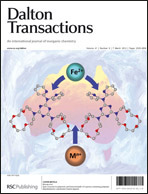Exchange coupling and magnetic anisotropy of exchanged-biased quantum tunnelling single-molecule magnet Ni3Mn2 complexes using theoretical methods based on Density Functional Theory†
Abstract
The magnetic properties of a new family of single-molecule magnet Ni3Mn2 complexes were studied using theoretical methods based on Density Functional Theory (DFT). The first part of this study is devoted to analysing the exchange coupling constants, focusing on the intramolecular as well as the intermolecular interactions. The calculated intramolecular J values were in excellent agreement with the experimental data, which show that all the couplings are ferromagnetic, leading to an S = 7 ground state. The intermolecular interactions were investigated because the two complexes studied do not show tunnelling at zero magnetic field. Usually, this exchange-biased quantum tunnelling is attributed to the presence of intermolecular interactions calculated with the help of theoretical methods. The results indicate the presence of weak intermolecular antiferromagnetic couplings that cannot explain the ferromagnetic value found experimentally for one of the systems. In the second part, the goal is to analyse magnetic anisotropy through the calculation of the zero-field splitting parameters (D and E), using DFT methods including the spin–orbit effect.


 Please wait while we load your content...
Please wait while we load your content...